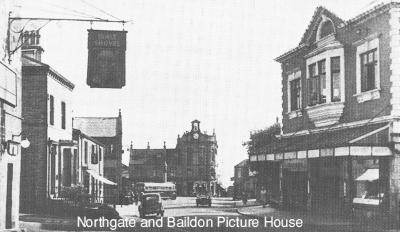|
Baildon Picture House Northgate, Baildon.
 Early Plans It was quite some time before building work commenced in late 1916 probably due to the war, shortage of labour and getting the plans passed by the Baildon Urban District Council. The New Building Despite the effects of the First World War (1914-1918) the picture house was built with an imposing two storey frontage in red brick with faience style white tile decoration and having a splendid central oriel style half hexagon bay window at first floor level suspended from the face of the building and supported on a substantial white corbel. A wrought iron and glass canopy was mounted above the front entrance. Its cosy auditorium with 550 seats had a proscenium width of 25 feet. Under the ownership of Joe Holmes who was already involved with the Shipley Picture House (and was later to take over the Hippodrome in Barkerend Road, Bradford) and famed for his flamboyant style, he opened the Baildon Picture House on Monday 5th February 1917 with the feature: Idol of the Stage - 1916 USA B/W Silent drama The local newspaper advertised . . . . It is undoubtedly a fact that no more up-to-date entertainment hall can be found anywhere than at Baildon. People visiting Baildon these weekends can spend a comfortable two hours in the Picture Theatre and may get all kinds of refreshments at the Café at moderate prices. Café also open on Sundays." A feature of the Baildon Picture House was that it had a large café upstairs and a dance floor with "Dancing to the Don Bell Orchestra" being a popular attraction. An old photograph taken shortly after its opening clearly shows a sign which reads "Picture House Café and Lounge open daily including Sundays". All this was at a time when Baildon was run as an Urban District Council (as was Shipley) and not part of the now sprawling Bradford Metropolitan District. Then as now Baildon was a popular place for city business people to live and for visitors and moor walkers at the weekend - all potential customers for the new cinema and café. In 1921 the Baildon Cinema Co Ltd was formed by the new owners Clifford Briggs (of Briggs Printers in Silsden) who was also proprietor of the Silsden Picture Palace. Briggs was joined by J.A Smith and J.D Smith of Keighley as principal shareholders. Silent films with piano accompaniment continued until the American Western Electric sound system was installed around 1930 bringing it into the "talkies" era. In September 1933 the Picture House was advertising a new feature: "When visiting Baildon (cinema) this weekend don't forget the café and also the New Amusement Arcade" - to attract the many weekend walkers who came to the moors just up the road. Later owners were Baildon Cinema Company with James Roberts as manager followed by A.H & N Cinema Circuit (P Artingstall) of Southport (also controlling the New Empire at Rawdon) who kept it going until 1939 when it closed for the duration of the Second World War (1939-1945) during which time the building was taken over (quite why is a mystery) by the Military and for housing evacuees. However, the popular café did continue to operate and was the setting for many formal dinners, wedding receptions and parties, eg. Baildon Army Cadets New Year Part in January 1945. At the last performance on Saturday 4th February 1939 the final film was: Slave Ship - 1937 USA B/W 100mins. Travelling Cinema Island Nation - Stanley Holloway presenting a naval study. After the War Pride & Prejudice - 1940 USA B/W 117 mins. Concert Performance Christine Roe (soprano); Margaret Whiteley (contralto); Press reports said "it was one of the best they have given and delighted a large gathering". Tickets for this special event were 2/6d, much more than the regular cinema prices. End of the Line CinemaScope was installed in early 1956 and seating capacity reduced to 396. Sadly this popular and comfortable little cinema only survived until Saturday 26th March 1960 when it closed with the final double X-certificate programme: The Mummy - 1959 UK Technicolor 88 mins. This landmark building for over 40 years was then used as a library for a while until the Ian Clough Hall opposite was built then the cinema and café building (excluding the butchers shop to the left of the entrance) were offered for sale to the council where it is recorded that . . . However, on the intervention of Councillor Reginald W. Bolton (aka "Inky" Bolton, a physics teacher with no interest in cinema!) who declared that the Council (Baildon U.D.C.) were likewise not interested in the proposal. That was the end of that and the cinema was demolished to allow for road widening and redevelopment with shops on the remainder of the site. Not to be copied or reproduced without permission.
|